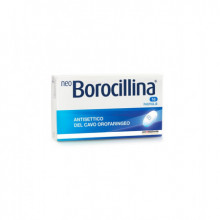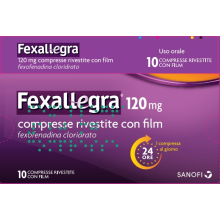NASAL FEXALLEGRA * SPRAY FL10ML
Therapeutic indications
Symptomatic treatment of allergic rhinitis, such as hay fever.
Dosage and method of use
Adults and children over 12 years: 1-2 sprays per nostril every 8-12 hours. Do not exceed the recommended dose. Duration of treatment: advise the patient that, in the absence of a complete therapeutic response within a few days, he must consult the doctor; in any case, the treatment must not be continued for more than 4 days. Pediatric population: the medicinal product is contraindicated in children below 12 years of age (see section 4.3).Method of administrationThe bottle must be used holding it vertically, to obtain spray nebulizations. For a correct use of the nebulizer, proceed as follows: Remove the protective cap after blowing your nose, keeping your head in the normal position, introduce the olive into the nostril and spray by pressing the bottle evenly once or twice with quick and energetic strokes. After nebulization, inhale deeply with your mouth closed, pressing lightly with your index finger on the other nostril, in order to ensure that the solution is distributed over the entire nasal mucosa. Then repeat the application in the other nostril. The empty space above the liquid is necessary for a perfect functioning of the bottle as a nebulizer. After use it is recommended to clean the olive and put on the protective cap.
Contraindications
Fexallegra nasale is contraindicated in the following cases: • Hypersensitivity to the active substances or to any of the excipients listed in section 6.1. • rhinitis sicca. • Heart disease and severe arterial hypertension. • Acute angle glaucoma. • Hyperthyroidism, prostatic hypertrophy. • Pregnancy and breastfeeding. • After cranial surgery performed nasally. • Children under the age of 12.
Side effects
The following convention has been used for the classification of undesirable effects: very common (≥1 / 10), common (≥1 / 100, Immune system disorders. Not known: hypersensitivity (skin edema, mucosal edema).Psychiatric disorders.Not known: hallucinations, insomnia, restlessness.Nervous system disorders.Not known: somnolence, sedation, headache, dizziness, dysgeusia.Cardiac pathologies.Not known: arrhythmias, tachycardia, palpitations.Respiratory, thoracic and mediastinal disorders.Not known: epistaxis, nasal edema, burning of the nose, nasal dryness, rhinorrhea, sneezing.Gastrointestinal disorders.Not known: nausea.Skin and subcutaneous tissue disorders.Not known: rash, itching.General disorders and administration site conditions.Not known: fatigue.Diagnostic tests.Not known: increase in blood pressure.Reporting of suspected adverse reactionsReporting of suspected adverse reactions that occur after authorization of the medicine is important, as it allows continuous monitoring of the benefit / risk ratio of the medicine. Healthcare professionals are asked to report any suspected adverse reactions via the national reporting system at www.agenziafarmaco.gov.it/it/responsabili.
Special warnings
Prolonged use of vasoconstrictors for topical nasal use can alter the normal function of the nasal mucosa and paranasal sinuses, causing chronic inflammation and atrophy; moreover it can also induce addiction to the drug. The use, especially if prolonged, of topical products can give rise to sensitization phenomena. When the vasoconstrictor effect of the drug ceases, edema of the nasal mucosa may occur due to reactive hyperemia.Mild and moderate arterial hypertensionDue to the potential risk of systemic absorption, Fexallegra nasale should be used with caution in patients with mild to moderate arterial hypertension; in these patients the use of nasal decongestants must however be subjected to clinical evaluation from time to time.Diabetes mellitusDuring treatment with sympathetic mimetic medicinal products, impaired glucose regulation may occur due to drug interaction with antidiabetic medicinal products or the effect on glucose metabolism. Due to the potential risk of systemic absorption, Fexallegra nasal should be used with caution in patients with diabetes mellitus.Pheochromocytoma and porphyriaDue to the potential risk of systemic absorption, Fexallegra nasale should be used with caution in patients with pheochromocytoma and porphyria.Elderly peopleIn the elderly, the medicine should be used with caution. Dizziness, sedation, confusion and hypotension may be more likely in elderly patients taking antihistamines. Elderly patients are particularly sensitive to the anticholinergic side effects of antihistamines, such as dry mouth and urinary retention (especially in male patients).Misuse / medication administration errorThe medicine should not be used orally. If accidentally ingested or if used for a long time in excessive doses, it can cause toxic phenomena. Accidental ingestion in children can cause severe central nervous system depression with marked sedation (see section 4.9). Contact of the liquid with the eyes can cause irritation.Important information about some of the ingredientsFexallegra nasale contains the preservative benzalkonium chloride which can cause irritation and, especially if used for long periods, persistent nasal congestion; in this case, a nasal medication without benzalkonium chloride or, alternatively, another pharmaceutical form should be used.
Pregnancy and breastfeeding
PregnancyThe medicinal product is contraindicated in pregnancy (see section 4.3).Feeding timeThe medicinal product is contraindicated during lactation (see section 4.3).FertilityNo studies have been conducted to investigate the effects on human fertility.
Expiration and retention
This medicine does not require any special storage conditions.
Interactions with other drugs
Antidepressant drugs and vasopressor drugsDue to the presence of the sympathomimetic agent tramazoline hydrochloride, Fexallegra nasale must not be administered together with antidepressant drugs and in the two weeks following the administration of the latter. The administration of nasal Fexallegra concomitantly with antidepressant drugs (MAO inhibitors or tricyclic antidepressants) or with vasopressor drugs, can cause an increase in blood pressure. Use in combination with tricyclic antidepressants can also cause arrhythmias. MAO inhibitors and tricyclic antidepressants may prolong and intensify the anticholinergic and central nervous system (CNS) depressant effects of chlorpheniramine maleate.CNS depressant drugsAlcohol, sedatives, opioid analgesics, hypnotics can cause increased sedation effects due to the antihistamine chlorpheniramine maleate.PhenytoinWhen taken concomitantly with phenytoin, chlorpheniramine maleate may lead to decreased elimination of phenytoin with an increased risk of phenytoin toxicity.Antihypertensive drugsInteractions with antihypertensive drugs, especially those whose action involves the sympathetic nervous system, can be complex and lead to various cardiovascular effects.
Overdose
SymptomsAn increase in blood pressure and tachycardia can, especially in children, be followed by a fall in blood pressure, subnormal temperatures, shock and reflex bradycardia. Similarly to other alpha-sympathomimetic drugs, the clinical picture of intoxication with nasal Fexallegra can be confused, since phases of stimulation and depression of the central nervous system and the cardiovascular system can alternate. Especially in children, intoxications produce effects on the Central Nervous System such as convulsions and coma, bradycardia, respiratory depression. Central nervous system stimulation symptoms are anxiety, agitation, hallucinations and convulsions. Central nervous system depression symptoms are hypothermia, lethargy, drowsiness and coma. In addition, the following symptoms may occur: mydriasis, miosis, sweating, fever, pallor, cyanosis of the lips, cardiovascular dysfunction, including cardiac arrest, respiratory dysfunction, including respiratory failure and respiratory arrest, psychological alterations. Similarly to other H1 antagonist drugs, in the case of acute intoxication with chlorpheniramine maleate, the greatest danger is represented by central excitatory effects. The syndrome includes hallucinations, arousal, ataxia, athetosis and convulsions. Dilated and fixed pupils with a flushed face may be found, along with sinus tachycardia, urinary retention, dry mouth and fever.TherapyIn case of nasal overdose, wash or clean the nasal mucous membranes carefully immediately. Symptomatic treatment may be required.
Active principles
1 ml of solution contains: tramazoline hydrochloride 1.18 mg equal to tramazoline 1.01 mg, chlorpheniramine maleate 5.05 mg equal to chlorpheniramine 3.55 mg (10 ml contain: tramazoline hydrochloride 11.8 mg, chlorpheniramine maleate 50.5 mg). Excipients with known effect: benzalkonium chloride. For the full list of excipients, see section 6.1
Excipients
benzalkonium chloride, liquid sorbitol, citric acid, disodium phosphate dihydrate, sodium chloride, purified water.

 Convenient and safe payments
Convenient and safe payments
 Shipping in 24h all over the world
Shipping in 24h all over the world
 Fast returns
Fast returns
 Pharmaceutical experience
Pharmaceutical experience















